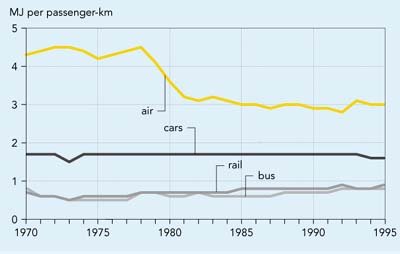Group 6: Technology and utilisation efficiency
Group policy context
The indicators in this group deal with
vehicle fleet composition (size, age and compliance with EU
environmental standards, fuel use), vehicle technology, utilisation
patterns (occupancy rates, load factors and distance driven) and
overall fleet performance in terms of energy intensity and
eco-efficiency.
The main policy instruments aimed at
improving technology and utilisation efficiency are:
- Auto-Oil Programme I and II (COM(95)689):
aim to improve the energy and emission efficiency of road transport and
improve the quality of fuels (see Group 1).
- The voluntary agreement with the car
industry (COM(98)495): aims to reduce CO2 emissions from new
passenger cars (see Group 1).
- EU strategies for the Citizens’ Network
(CEC, 1995): aims to improve the utilisation efficiency of passenger
car transport (e.g. to develop traffic priority for vehicles with more
than one person and initiatives to promote car-sharing).
- Some Member States have introduced schemes
to encourage scrapping of old vehicles (i.e. to remove vehicles with
the worst environmental performance).
- The Proposal for a Directive on end-of-life
vehicles ((CEC, 1997), amended by COM (99) 176) would make producers
liable for the recycling of end-of-life vehicles.
- International Civil Aviation Organization
(ICAO) standards on noise from aircraft are being strengthened so as to
phase out the noisiest. Similarly, ICAO sets standards on air emissions
from aircraft. The recent Commission Communication on air transport and
the environment (CEC, 1999), announces a strategy to enhance technical
standards and rules for aircraft (for noise and gaseous
emissions).
- Under the International Convention for the
Prevention of Pollution from Ships (MARPOL), a new protocol to reduce
pollution emissions (NOx, SO2) from ships was
proposed in 1997 but has not yet been adopted.
- EU demonstration and promotion programmes
such as:
- SAVE II (Decision 91/565 and 96/737): aims
to increase the energy efficiency of goods and passenger transport by
promoting energy management in regions and cities to reduce consumption
and CO2 emissions;
- THERMIE (EEC No 2008/90): aims to promote
more efficient energy technology, mainly through measures to improve
overall efficiency of public transport systems;
- ALTENER II (COM(97)550, COM(99)212): aims to
promote increased use of renewable fuels.
Group key findings
Figure 6.1: Energy intensity of
passenger transport (8 EU countries)

Source: International Energy
Studies, Lawrence Berkeley Laboratory, as
compiled from recognised national sources
Note: 1 Mega joule (MJ) = 106 Joule) =
0.024 tonne oil equivalent (toe)
- The most significant success in this group
is the phasing-out of leaded petrol; the market share of unleaded
petrol reached 75 % in 1997 and leaded petrol is expected to be
completely phased out by 2005.
- Although vehicle fuel efficiency, related
primarily to technology, has improved in all modes, changes in fleet
composition (e.g. heavier cars) and vehicle utilisation (i.e.
decreasing occupancy rates and low load factors) have absorbed much of
the impact in most countries. As a result, the energy intensity of road
and rail passenger and freight transport has not improved since the
beginning of the 1970s. The energy intensity of air transport achieved
a significant improvement in the 1970s, but has stagnated since
then.
- Road freight transport and air passenger
transport are the modes with the highest energy intensity. Rail and
ship freight transport are still much more energy-efficient than road
freight transport.
- A further factor that limits the benefits of
new technologies has been the slow market penetration of new cars; the
average age of the car fleet increased from 6.1 years in 1980 to 7.0
years in 1997. Several Member States (Greece, Denmark, Spain, France,
Ireland and Italy) have introduced car-scrapping schemes during the
1990s. Of course such programmes only result in environmental
improvements if the new vehicles have emission rates substantially
better than older models and if the environmental impact of vehicle
construction and dismantling processes is reduced. The proposed
Directive on end-of-life vehicles aims to ensure this.
- Data on eco-efficiency of passenger and
freight transport is scarce, but in Austria and the Netherlands
specific emissions of NOx and NMVOCs from road as well as
rail and air transport have dropped significantly. The main causes are
the introduction of EU standards on emissions from new passenger cars
(the catalytic converter) and diesel vehicles. This result depends on
the characteristics of the vehicle fleets – 76 % of the Austrian
and Dutch car fleet is fitted with catalytic converters, compared with
an EU average of 48 %.
- In 1995 70 % of diesel-driven cars and
23 % of heavy-duty vehicles complied with EURO I, and more than
90 % of the EU aircraft fleet complied with the highest noise
standard for aircraft.
- Stringent technical and fuel standards have
proved to be powerful policy instruments for curbing some of the
environmental impacts of transport. However, reaping the full benefits
of technological improvements and higher standards requires economic
and other incentives to regulate transport demand. For example an
increase in energy efficiency lowers fuel costs per km, encourages more
transport, and therefore undermines the benefits.

Document Actions
Share with others